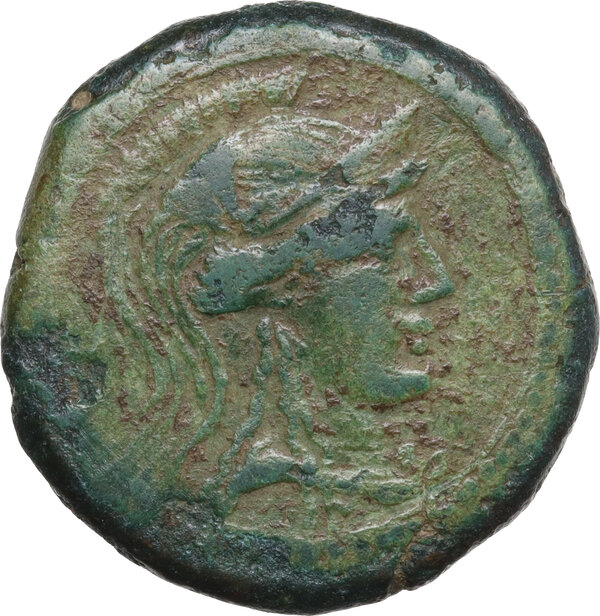

Greek Italy. Central and Southern Campania, Capua. AE Quincunx, c. 216-211 BC. Obv. Head of Minerva, wearing Attic helmet right. Rev. KAPU in Oscan letters. Pegasos flying right; five pellets below. HN Italy 482; HGC 1 380; SNG ANS 201; Graziano 2 e 10. 22.34 g. 31.00 mm. R. Rare. Weight in ink on reverse. Green patina, roughness. VF.
At the outbreak of the Second Punic War (218-201 BC) between Roma and Carthage, Capua was regarded in Italy as a city second only to Rome in terms of wealth and influence. When the Romans were brought low by the victory of Hannibal at the Battle of Cannae (216 BC), the Campanians sent emissaries to Rome to seek confirmation of Capua's importance, arguing that one of the annual consuls should come from the city. The Romans would not accept the Campanian request. In response the gates of Capua were opened to welcome the Carthaginian army. Capua served as Hannibal's winter quarters until 211 BC, when the city was besieged and captured by the Roman proconsul Q. Fulvius Flaccus.
This Quincunx belongs to the first Capua's series, based on an As of c. 66 gr.
Ex Coll. E. J. Haeberlin.
Roman mythological tradition attributed the foundation of Capua (Capu in Oscan) to Capys, a descendant of the Trojan hero, Aeneas. However, the historical city seems to have been an Etruscan settlement with origins extending back into the Villanovian culture period (c. 1100-700 BC).At the outbreak of the Second Punic War (218-201 BC) between Roma and Carthage, Capua was regarded in Italy as a city second only to Rome in terms of wealth and influence. When the Romans were brought low by the victory of Hannibal at the Battle of Cannae (216 BC), the Campanians sent emissaries to Rome to seek confirmation of Capua's importance, arguing that one of the annual consuls should come from the city. The Romans would not accept the Campanian request. In response the gates of Capua were opened to welcome the Carthaginian army. Capua served as Hannibal's winter quarters until 211 BC, when the city was besieged and captured by the Roman proconsul Q. Fulvius Flaccus.
This Quincunx belongs to the first Capua's series, based on an As of c. 66 gr.


